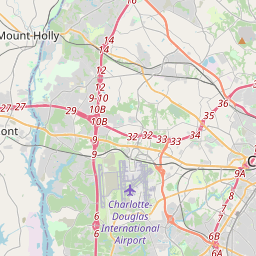The Sculptures at Independence Square
Historical marker location:
Charlotte, North Carolina
( Marker is at the intersection of North Tryon Street and East Trade Street, on the right when traveling north on North Tryon Street.)







© OpenStreetMap contributors
Bronze Boundary Figures by Raymond Kaskey. Given to the people of Charlotte by the Queens Table, November 1995
Loading...
Searching for other points of interest within 3 miles of this location.The Cherokee Indians originally inhabited much of western North Carolina before being forcibly removed by the federal government in the 1800s. Today, the Eastern Band of Cherokee Indians still maintains a reservation in the western part of the state.
About Mecklenburg County
Mecklenburg County Timeline
Mecklenburg County, located in the state of North Carolina, has a rich and varied history that spans several centuries. The region was originally home to indigenous Native American tribes, including the Catawba and Cherokee, who cultivated the land and developed their own societies. European exploration and settlement began in the late 17th century, with German and Scotch-Irish immigrants establishing farms and trading posts in the area.
In 1762, Mecklenburg County was officially formed out of Anson County, named after Princess Charlotte of Mecklenburg-Strelitz, who married King George III of England. The county quickly became an important center of commerce and trade, with Charlotte, its county seat and largest city, serving as a major trading hub in the early days of the nation. The region's fertile land, proximity to waterways, and growing transportation networks made it an important agricultural and industrial region, contributing to its economic growth.
During the American Revolution, Mecklenburg County played a key role in the fight for independence. In 1775, the Mecklenburg Declaration of Independence, also known as the Mecklenburg Resolves, was adopted, declaring the county's independence from British rule more than a year before the more famous Declaration of Independence. While the authenticity and exact wording of this declaration have been debated, it remains an important symbol of the county's early commitment to the Revolutionary cause.
In the years that followed, Mecklenburg County continued to thrive and grow. It saw significant development during the 19th century, with industries like cotton mills and textile manufacturing taking root. The county's prosperity attracted a diverse population, including African Americans who migrated to the area in search of economic opportunities. Today, Mecklenburg County is a thriving and vibrant region with a mix of urban and rural areas, serving as a cultural, educational, and economic center for the state of North Carolina.
In 1762, Mecklenburg County was officially formed out of Anson County, named after Princess Charlotte of Mecklenburg-Strelitz, who married King George III of England. The county quickly became an important center of commerce and trade, with Charlotte, its county seat and largest city, serving as a major trading hub in the early days of the nation. The region's fertile land, proximity to waterways, and growing transportation networks made it an important agricultural and industrial region, contributing to its economic growth.
During the American Revolution, Mecklenburg County played a key role in the fight for independence. In 1775, the Mecklenburg Declaration of Independence, also known as the Mecklenburg Resolves, was adopted, declaring the county's independence from British rule more than a year before the more famous Declaration of Independence. While the authenticity and exact wording of this declaration have been debated, it remains an important symbol of the county's early commitment to the Revolutionary cause.
In the years that followed, Mecklenburg County continued to thrive and grow. It saw significant development during the 19th century, with industries like cotton mills and textile manufacturing taking root. The county's prosperity attracted a diverse population, including African Americans who migrated to the area in search of economic opportunities. Today, Mecklenburg County is a thriving and vibrant region with a mix of urban and rural areas, serving as a cultural, educational, and economic center for the state of North Carolina.
Mecklenburg County Timeline
This timeline provides a concise overview of the key events in the history of Mecklenburg County, North Carolina.
- 1762 - Mecklenburg County is formed from Anson County
- 1768 - Charlotte, the county seat, is incorporated
- 1774 - The Mecklenburg Resolves, a document declaring independence from Britain, is signed
- 1775 - The Mecklenburg Declaration of Independence is alleged to have been signed on May 20
- 1776 - The county courthouse is burned down during the Revolutionary War
- 1799 - The University of North Carolina is chartered in Charlotte, but is later moved to Chapel Hill
- 1837 - The first railroad line in Mecklenburg County is completed
- 1865 - General William T. Sherman's troops occupy Charlotte during the Civil War
- 1891 - Charlotte's first electric streetcar system is introduced
- 1973 - Development of Charlotte Douglas International Airport begins
- 1992 - Charlotte hosts the Democratic National Convention
- 2012 - Charlotte hosts the Democratic National Convention for a second time